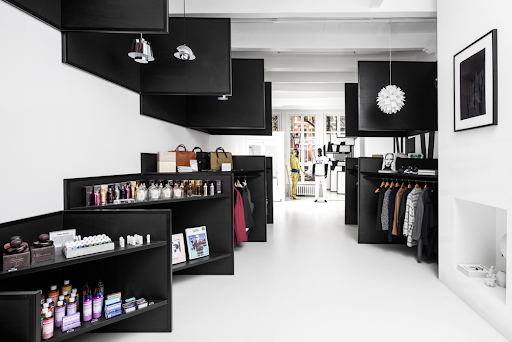
Regarding commercial spaces, aesthetics and functionality often take centre stage. However, ergonomics is one crucial factor that should always be considered in creating visually-appealing and efficient environments. Ergonomics plays a vital role in commercial shopfitting by ensuring that spaces are aesthetically-pleasing, safe and comfortable for both customers and employees. In this blog, we will delve into the significance of ergonomics in commercial shopfitting and explore how it can be effectively integrated into the design process.
Understanding ergonomics in commercial spaces:
Ergonomics is the science of designing and arranging spaces, products, and systems to optimise peoples’ well-being and overall performance. When applied to commercial shopfitting, it creates spaces promoting user comfort, safety, and efficiency. This involves considering factors such as proper lighting, appropriate furniture, efficient layout, and ease of movement.
The impact of ergonomics on customers:
Customers are at the heart of any commercial space, and their experience can significantly influence the success of a business. A shop that considers ergonomics is more likely to attract and retain customers. For instance, comfortable seating areas, easily-accessible product displays, and well-lit spaces make customers feel welcome and encourage them to spend more time exploring and purchasing. Ergonomics also considers proper signage and wayfinding factors, making it easier for customers to navigate the space and find what they need.
Enhancing employee well-being and productivity:
While customers are a priority, employee well-being should always be noticed. In a retail setting, employees spend long hours on their feet, interacting with customers and managing merchandise. Incorporating ergonomic principles into the shopfitting design can significantly impact their comfort and productivity.
Adjustable workstations, ergonomic chairs, and well-placed tools and equipment can help reduce the risk of musculoskeletal disorders and fatigue, ultimately leading to happier and more efficient employees.
Key considerations for ergonomic commercial shopfitting:
Layout and flow:
An ergonomic layout ensures that spaces are organised logically, minimising congestion and promoting smooth traffic flow. This can be achieved through clearly defined pathways, strategically-positioned displays, and ample space for customers and employees to move around.
Furniture and fixtures:
Selecting ergonomic furniture is essential for customer comfort. Ergonomic chairs and seating provide proper support, reducing strain on the body. Similarly, adjustable shelves and display units allow for easy access and rearrangement of products.
Lighting:
Proper lighting is essential in commercial spaces. Natural lighting should be maximised whenever possible, and artificial lighting should be carefully chosen to prevent glow and provide adequate illumination for customers and employees.
Colours and materials:
The choice of colours and materials can influence a space’s overall ambience and comfort. Too bright or intense colours can create discomfort, while materials should be selected for durability and tactile comfort.
Height and reach:
Merchandise should be displayed at various heights, accommodating customers of different heights and abilities. Products that are easily reachable ensure a positive shopping experience for everyone.
Workstation design:
Employee workstations should be designed with ergonomics in mind. Adjustable desks, ergonomic chairs, and proper computer screen placement can reduce the risk of strain and injuries.
The collaboration of design and ergonomics:
Integrating ergonomic principles into commercial shopfitting requires collaboration between designers, architects, and ergonomics experts. Designers need to understand the business’s specific needs, the type of products or services offered, and the target audience. By working closely with ergonomics experts, they can create a design that reflects the brand’s identity and prioritises the well-being of customers and employees.
Integrating technology for enhanced ergonomics:
In the rapidly evolving world of technology, incorporating smart solutions into commercial shopfitting can elevate the ergonomic experience. Automated doors, motion-sensor lighting, and touchless interfaces provide a seamless and hygienic environment. Additionally, interactive displays and digital signage engage customers and allow them to access information without straining or contorting their bodies.
Creating multi-functional spaces:
Modern commercial spaces are often expected to serve multiple purposes. Whether it’s a cafe within a bookstore or a lounge area within a retail store, incorporating ergonomic design principles can make these spaces versatile and accommodating. Modular furniture that can be easily rearranged, convertible seating arrangements, and hidden storage solutions maximise the utility of these spaces while maintaining ergonomic comfort.
Ergonomics and accessibility:
An essential aspect of ergonomic design in commercial spaces is ensuring accessibility for all individuals, regardless of their physical abilities. Incorporating features such as ramps, elevators, and accessible restrooms is crucial to creating an inclusive environment. Furthermore, digital interfaces should be designed with accessibility, including features for those with visual or hearing impairments.
Environmental sustainability and ergonomics:
The ergonomics concept isn’t limited to human comfort but extends to the broader environment. Sustainable design practices can significantly impact the comfort of a commercial space. Using eco-friendly materials, energy-efficient lighting systems, and natural ventilation contributes to a healthier planet and creates a more comfortable and pleasant atmosphere for occupants.
Ongoing evaluation and adaptation:
Ergonomic design isn’t a one-time endeavour; it requires continuous evaluation and adaptation. Commercial spaces must also evolve as customer preferences, technology, and business needs evolve. Regularly assessing the ergonomic aspects of an area, gathering feedback from customers and employees, and making necessary adjustments ensure that the area remains optimally comfortable and functional.
Measuring the impact of ergonomics:
As businesses invest in ergonomic shopfitting, it’s crucial to measure the impact of these efforts. Metrics such as customer satisfaction, employee absenteeism, and productivity can provide valuable insights into the effectiveness of the ergonomic design. By collecting and analysing data, businesses can make informed decisions about the design elements working well and those needing improvement.
Conclusion:
Ergonomics in commercial shopfitting goes beyond creating visually-appealing spaces; it’s about enhancing the comfort, safety, and overall experience for everyone interacting with the environment. From customers to employees and from accessibility to sustainability, ergonomic principles play a pivotal role in shaping successful commercial spaces.
As businesses continue to recognise the value of ergonomic design, the collaboration between designers, architects, and ergonomics experts will undoubtedly lead to more innovative and comfortable spaces that stand the test of time. By prioritising ergonomics, businesses invest in their physical areas and the well-being and satisfaction of those who inhabit them.
